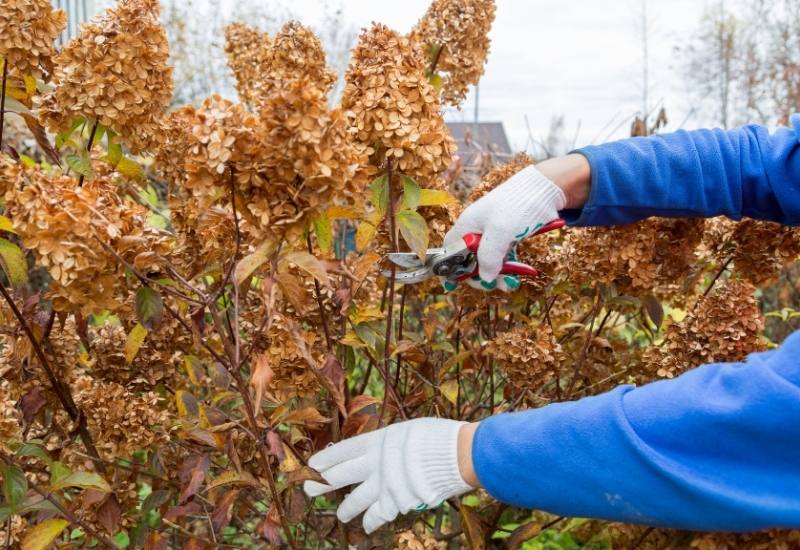
We all love hydrangeas for their vigorous growth, long and massive blooms, and because they are very low maintenance, but if you want to give your flowering shrub a hand with its blossoms, try deadheading spent flowers from your hydrangeas…
While these herbaceous beauties don’t even need pruning in most cases, if you snip off wilted, fading, or “spent” flower heads, you will encourage them to start anew with more and more colorful inflorescences.
Deadheading hydrangeas is a simple operation you can carry out with a small blade, like a grafting knife and even with your fingers, but it can go a long way to make your garden florid and colorful for longer and later during the season.
In simple but comprehensive steps, we will go through why, when and how to deadhead hydrangeas so you can get bigger and longer blossoms from your beautiful shrubs.
What Do We Mean By Deadheading?
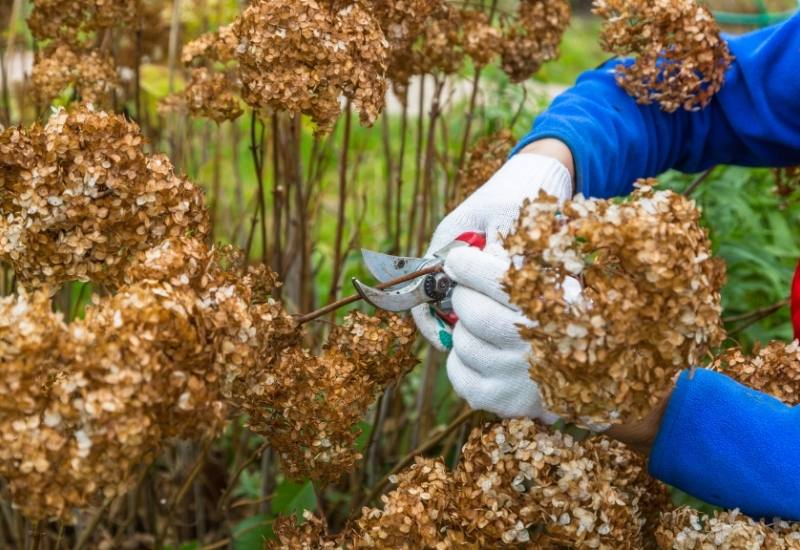
“Deadheading” sounds like an evil word, but there is nothing bad about it. It simply means to remove the flowers from a plant once they have spent, and before they develop seeds or rot away…
It is not a form of pruning, because you don’t affect the branches at all. It is more alike to chores of cleaning and tidying up plants.
We do it with many flowers, including, of course, roses, carnations, peonies, camellias, with reblooming varieties and, of course, also with hydrangeas.
Why You Should Deadhead Hydrangeas
There are a few reasons why you should cut off brown hydrangea blooms, and they are linked to their blooming pattern and to the climate. Let’s see them.
1: Deadheading Hydrangeas Encourages Reblooming
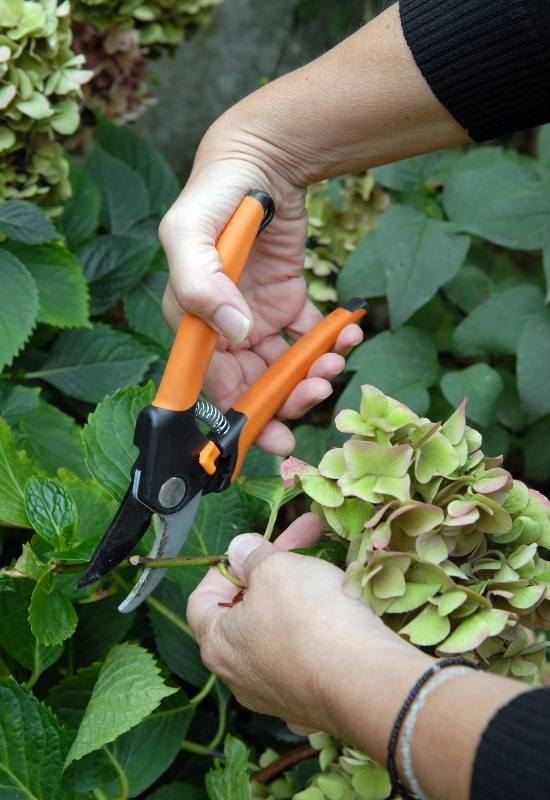
Hydrangeas can bloom in spring, summer and even early or even mid fall in some regions. It depends on the variety or cultivar you grow, and it also depends on the climate. Most hydrangeas will bloom for about three to four months, but…
In this time, hydrangeas may stop blooming; this usually happens in summer when the days are too hot. Our flowering shrubs don’t like excessive heat, and the stress stops them from flowering.
Moreover, while each inflorescence can last a long time indeed, for weeks, the overall bloom is made up by successive and usually continuous blossoms.
Once a blossom is spent, your plant will divert its energy to producing seeds; this means that it won’t invest in as many new blooms. If you remove fading or spent blooms from your hydrangea, the plant will try again to reproduce, and it will have the energy to do it by producing new inflorescences.
Also, later blossoms will be more vigorous if you deadhead earlier ones, for the same reason.
If your hydrangea suffers from heat shock and it stops blooming in summer, you really need to deadhead it; this will also improve the health of your shrub.
But there are more reasons…
Removing Spent Blooms Reduce The Risk Of Rotting
When a hydrangea bloom is spent, it usually dries up. But if the season is rainy and wet (like in spring or fall, or in some places, even in summer), they risk rotting instead.
Each bloom can be quite large up to 1 foot across, or 30 cm (the white and rose pink ‘Avantgarde’ is the largest of all!).
This means that they can hold a lot of water and humidity, and this can then cause infections to the stems and leaves in turn.
So, always deadhead your hydrangeas if the spent blooms are getting humid.
Finally, there is another reason why you may want to deadhead your shrubs.
Deadheading Hydrangeas Helps To Maintain A Neat And Tidy Appearance
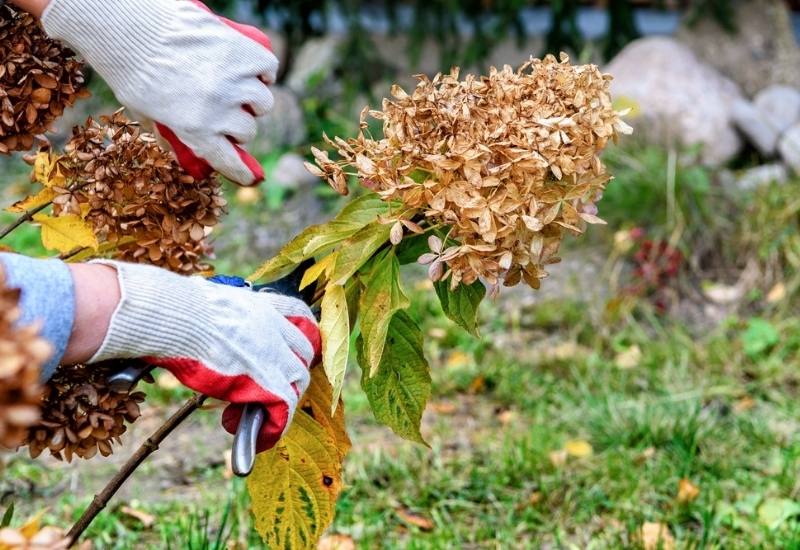
The last, and maybe most obvious, reason why you should deadhead hydrangeas is that spent inflorescences don’t loom attractive at all.
They will stay on the branches for a long time, turning brown and unappealing. This alone is a good reason to snip them off.
And now we can see when you can deadhead your hydrangeas.
When To Deadhead Hydrangeas For Maximum Bloom
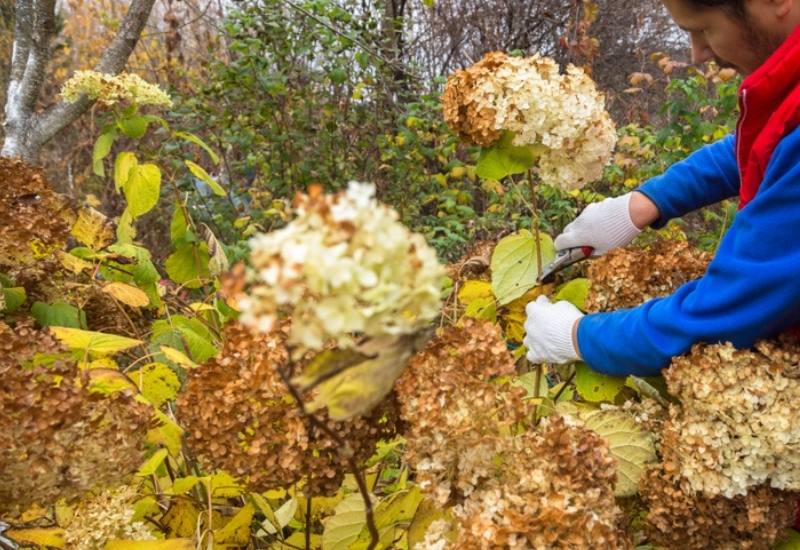
The exact moment when you deadhead hydrangeas is up to you. For sure, when all or most of the flowers in the inflorescence are spent is a good rule of thumb.
Some gardeners may do it earlier, when there are still some beautiful flowers in each cluster, others wait for the very last flower to wilt.
I am in the second group, but there are many reasons why you could prefer to be in the first; for example, you may like a fresh looking garden, or you may have guests, or, imagine if you wanted to present your hydrangea to a gardening competition…
So, you have some flexibility with the exact timing. But for sure don’t leave spent blooms on the branches for long.
Where you don’t have the same flexibility is with how you deadhead your hydrangeas though. Let’s talk about it…
How to Deadhead Your Hydrangeas
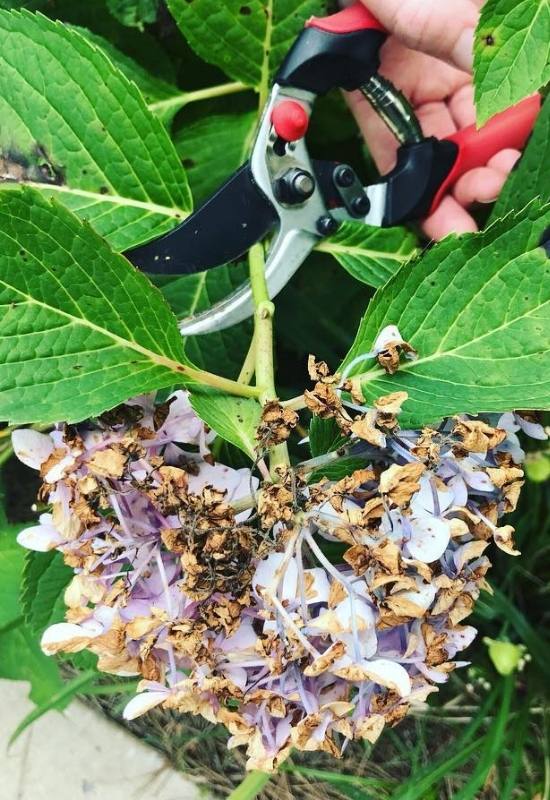
Put simply, there are two ways of deadheading hydrangeas, but one point on the stem to do it: you should cut the stem just above the first set of healthy leaves you find going down the stem from the blossom.
This is the general rule, and it is good especially for beginners. However, once you get to know your hydrangeas, you can move a step further, or even two…
If the stem you cut is dry, you can cut further back till you get to the living part of the stem. Always keep above the first set of healthy leaves though.
Finally, once you become a real expert, you will know that if the stem is large and brown, it will not produce new blooms.
Even if it is healthy. So, gardeners who have grown hydrangeas for a long time like to cut them too, down to where they see new lateral buds.
This is part pruning, part deadheading; it encourages new branches which will bring new flowers. But never over-prune your hydrangeas. This is a skill you will acquire with experience.
And now, let’s see how you can actually do the cut…
Deadheading Hydrangeas with Your Fingers
Some gardeners like to deadhead hydrangeas by simply snipping off the spent bloom with their fingers.
However, I would advise against it; hydrangeas have fibrous stems, and in many cases, you end up “ripping” it, and the wound with exposed tissue may end up rotting or catching infections.
So, the best way to deadhead a hydrangea is…
Deadheading Hydrangeas with a Blade
Be safe and procure yourself a pair of sharp secateurs, pruning shears or even a pruning knife. These will guarantee a sharp cut which soon heals stopping infections and rot.
You don’t need any bigger or more expensive tools to deadhead hydrangeas, like bypass loppers… Actually they are far too big and “clumsy” for this type of intervention, keep them for actual pruning…
But there is one thing you must do before you apply the blades to the stem: disinfect them! Have you ever seen pruned or cut stems catch diseases?
Of course you have. In many cases, it is the blade itself that carries pathogens from one plant to another, straight into the wound!
Use apple cider vinegar or alcohol to sanitize your secateurs or pruning knife, and do it for every new shrub. This way, you will have both surgical precision and hygiene for your plants.
Deadheading Hydrangeas: A Simple Way To Keep Them Healthy And Beautiful
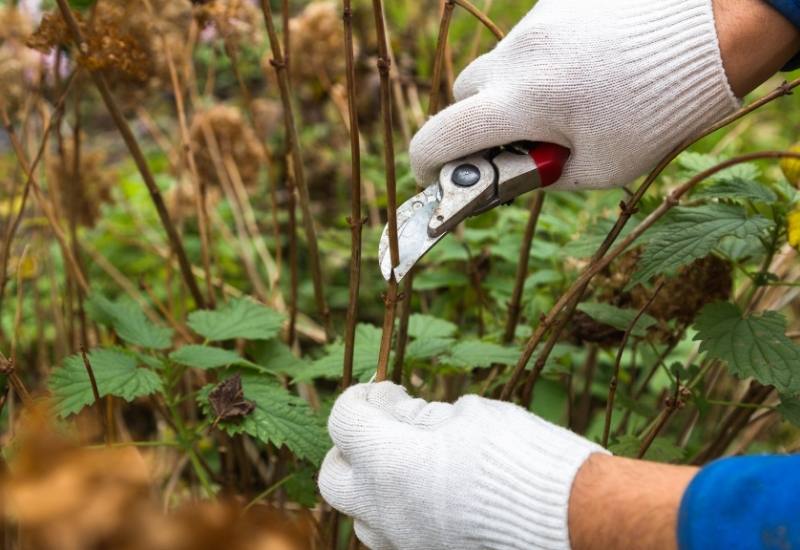
As long as you know why, when and how to deadhead your hydrangeas, you run no risks! It’s a very simple operation, with few rules and lots of benefits for your shrubs.
So, from now on, you too can have them blooming longer and with more vigor, just like a professional gardener!

Written By
Adriano Bulla
After many years as an academic in London, Adriano Bulla became a writer, publishing books like A History of Gardening, Organic Gardening and Elements of Garden Design; he then decided to become a gardener, following his childhood dream, and has been following his dream writing and gardening professionally in Southern Europe, where he has specialized in new and innovative organic gardening fields and techniques, like permaculture, regenerative agriculture, food forests and hydroponics.

Thank you of your advice. I’m a new hydrangea owner and I want to make sure they are healthy and beautiful. I got an Endless Summer for my first one.
Thank you very much. I finally have a beautiful, healthy hydrangea and naturally I want to make it last if I can. I did not know about many things you wrote about here, including to disinfect the pruning utensil!!!! Much appreciated your advice.
I felt that the heaviness of the spent blooms, especially if it snows here soon, would crack many stems further down than might be healthy for them. Is this right? Thanks